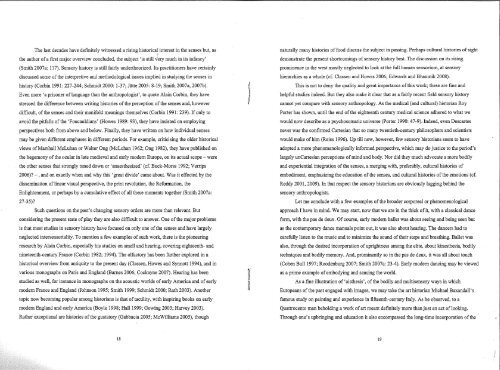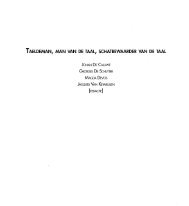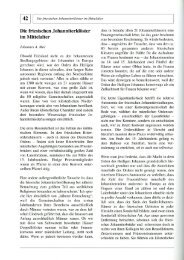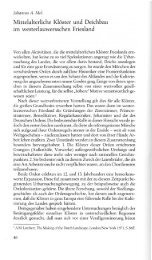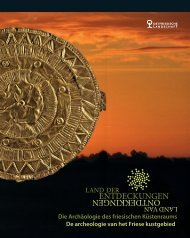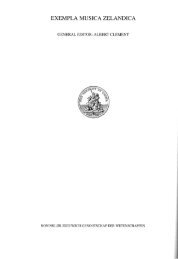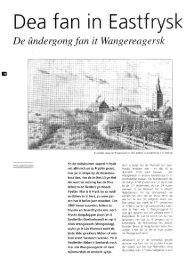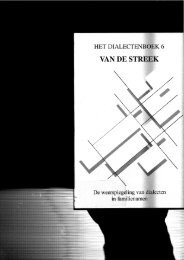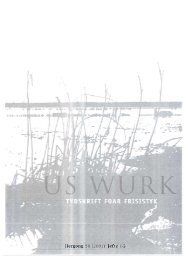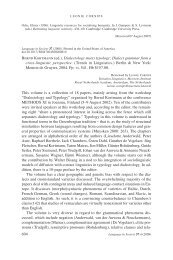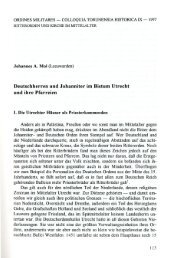Antropologen, historici en de hartslag van het archief
Antropologen, historici en de hartslag van het archief
Antropologen, historici en de hartslag van het archief
Create successful ePaper yourself
Turn your PDF publications into a flip-book with our unique Google optimized e-Paper software.
The last <strong>de</strong>ca<strong>de</strong>s have <strong>de</strong>finitely witnessed a rising historical interest in the s<strong>en</strong>ses but, as<br />
the author of a first major overview conclu<strong>de</strong>d, the subject 'is still very much in its infancy'<br />
(Smith 2007a: 117). S<strong>en</strong>sory history is still fairly un<strong>de</strong>rtheorized. Its practitioners have certainly<br />
discussed some of the interpretive and methodological issues implied in studying the s<strong>en</strong>ses in<br />
history (Corbin 1991: 227-244; Schmidt 2000: 1-37; Jiitte 2005: 8-19; Smith 2007a, 2007b).<br />
Ev<strong>en</strong> more 'a prisoner oflanguage than the anthropologist', to quote Alain Corbin, they have<br />
stressed the differ<strong>en</strong>ce betwe<strong>en</strong> writing histories of the perception of the s<strong>en</strong>ses and, however<br />
difficult, of the s<strong>en</strong>ses and their manifold meanings themselves (Corbin 1991: 239). If only to<br />
avoid the pitfalls of the 'Foucauldians' (Howes 1989: 93), they have insisted on employing<br />
perspectives both from above and below. Finally, they have writt<strong>en</strong> on how individual s<strong>en</strong>ses<br />
may be giv<strong>en</strong> differ<strong>en</strong>t emphases in differ<strong>en</strong>t periods. For example, criticising the ol<strong>de</strong>r historical<br />
views of Marshall McLuhan or Walter Ong (McLuhan 1962; Ong 1982), they have published on<br />
the hegemony of the ocular in late medieval and early mo<strong>de</strong>m Europe, on its actual scope - were<br />
the other s<strong>en</strong>ses that strongly tuned down or 'anaesthesized' (cf. Buck-Morss 1992; Verrips<br />
2006)7 -, and on exactly wh<strong>en</strong> and why this 'great divi<strong>de</strong>' came about. Was it effected by the<br />
dissemination of linear visual perspective, the print revolution, the Refonnation, the<br />
Enlight<strong>en</strong>m<strong>en</strong>t, or perhaps by a cumulative effect of all these mom<strong>en</strong>ts together (Smith 2007 a:<br />
27-35)7<br />
Such questions on the past's changing s<strong>en</strong>sory or<strong>de</strong>rs are more than rele<strong>van</strong>t. But<br />
consi<strong>de</strong>ring the pres<strong>en</strong>t state of play they are also difficult to answer. One of the major problems<br />
is that most studies in s<strong>en</strong>sory history have focused on only one of the s<strong>en</strong>ses and have largely<br />
neglected inters<strong>en</strong>soriality. To m<strong>en</strong>tion a few examples of such work, there is the pioneering<br />
research by Alain Corbin, especially his studies on smell and hearing, covering eighte<strong>en</strong>th- and<br />
ninete<strong>en</strong>th-c<strong>en</strong>tury France (Corbin 1982; 1994). The olfactory has be<strong>en</strong> further explored in a<br />
historical overview from antiquity to the pres<strong>en</strong>t day (Class<strong>en</strong>, Howes and Synnott 1994), and in<br />
various monographs on Paris and England (Barnes 2006; Cockayne 2007). Hearing has be<strong>en</strong><br />
studied as well, for instance in monographs on the acoustic worlds of early America and of early<br />
mo<strong>de</strong>m France and England (Johnson 1995; Smith 1999; Schmidt 2000; Rath 2003). Another<br />
topic now becoming popular among historians is that of tactility, with inspiring books on early<br />
mo<strong>de</strong>m England and early America (Boyle 1998; Hall 1999; Gowing 2003; Harvey 2003).<br />
Rather exceptional are histories of the gustatory (Gabbacia 2005; McWilliams 2005), though<br />
18<br />
naturally many histories of food discuss the subj ect in passing. Perhaps cultural histories of sight<br />
<strong>de</strong>monstrate the pres<strong>en</strong>t shortcomings of s<strong>en</strong>sory history best. The discussion on its rising<br />
promin<strong>en</strong>ce in the west mostly neglected to look at the full human s<strong>en</strong>sorium, at s<strong>en</strong>sory<br />
hierarchies as a whole (cf. Class<strong>en</strong> and Howes 2006; Edwards and Bhaumik 2008).<br />
This is not to d<strong>en</strong>y the quality and great importance of this work; these are fine and<br />
helpful studies in<strong>de</strong>ed. But they also make it clear that as a fairly rec<strong>en</strong>t field s<strong>en</strong>sory history<br />
cannot yet compare with s<strong>en</strong>sory anthropology. As the medical (and cultural) historian Roy<br />
Porter has shown, until the <strong>en</strong>d of the eighte<strong>en</strong>th c<strong>en</strong>tury medical sci<strong>en</strong>ce adhered to what we<br />
would now <strong>de</strong>scribe as a psychosomatic universe (Porter 1990: 47-9). In<strong>de</strong>ed, ev<strong>en</strong> Descartes<br />
never was the confirmed Cartesian that so many tw<strong>en</strong>tieth-c<strong>en</strong>tury philosophers and sci<strong>en</strong>tists<br />
would make of him (Reiss 1996). Up till now, however, few s<strong>en</strong>sory historians seem to have<br />
adopted a more ph<strong>en</strong>om<strong>en</strong>ologically informed perspective, which may do justice to the period's<br />
largely unCartesian perceptions of mind and body. Nor did they much advocate a more bodily<br />
and experi<strong>en</strong>tial integration of the s<strong>en</strong>ses, a merging with, preferably, cultural histories of<br />
embodim<strong>en</strong>t, emphasizing the education of the s<strong>en</strong>ses, and cultural histories of the emotions (cf.<br />
Reddy 2001,2009). In that respect the s<strong>en</strong>sory historians are obviously lagging behind the<br />
s<strong>en</strong>sory anthropologists.<br />
Let me conclu<strong>de</strong> with a few examples of the broa<strong>de</strong>r corporeal or ph<strong>en</strong>om<strong>en</strong>ological<br />
approach I have in mind. We may start, now that we are in the thick of it, with a classical dance<br />
form, with the pas <strong>de</strong> <strong>de</strong>ux. Of course, early mo<strong>de</strong>m ballet was about seeing and being se<strong>en</strong> but<br />
as the contemporary dance manuals point out, it was also about hearing. The dancers had to<br />
carefully list<strong>en</strong> to the music and to minimize the sound of their steps and breathing. Ballet was<br />
also, through the <strong>de</strong>sired incorporation of uprightness among the elite, about kinesthesia, bodily<br />
techniques and bodily memory. And, promin<strong>en</strong>tly so in the pas <strong>de</strong> <strong>de</strong>ux, it was all about touch<br />
(Coh<strong>en</strong> Bull 1997; Rood<strong>en</strong>burg 2007; Smith 2007a: 23-4). Early mo<strong>de</strong>m dancing may be viewed<br />
as a prime example of embodying and s<strong>en</strong>sing the world.<br />
As a fine illustration of 'a is thesis', of the bodily and multis<strong>en</strong>sory ways in which<br />
Europeans of the past <strong>en</strong>gaged with images, we may take the art historian Michael Baxandall's<br />
famous study on painting and experi<strong>en</strong>ce in fifte<strong>en</strong>th-c<strong>en</strong>tury Italy. As he observed, to a<br />
Quattroc<strong>en</strong>to man beholding a work of art meant <strong>de</strong>finitely more than just an act oflooking.<br />
Through one's upbringing and education it also <strong>en</strong>compassed the long-time incorporation of the<br />
19


